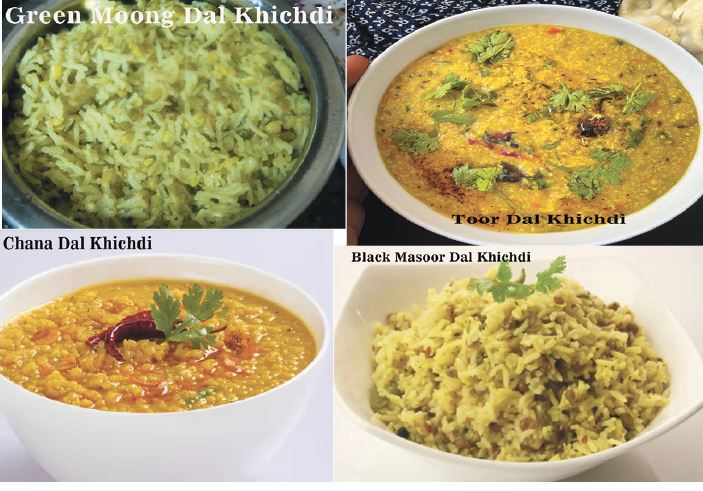Goa is abuzz with excitement as vintage bike and car owners, users, collectors and fans are decking […]

`KICHADI’ IS INDIA’S COMFORT FOOD!
Aug 16- Aug 22, 2025, Eating is Fun / Eating is Yuck! - A variety food column, Life & Living August 15, 2025EVERY country has its comfort food recipe and in India in more states than I can count I think it is “kichdi” or “kichadi” which just translates to something like a melodious mess of a recipe which folk crave for … especially when made with love and affection. It is “kichdi” or “kichadi” or even “khichuri” (the softer notes of Bengali in the word), however you want to pronounce it. On a bad or even a good day I can survive on just plain green mung dal khichdi laced in home-made curd spiked with a bit of roasted cumin powder and black salt (“sanchar” in Gujarati).
I should think kichadi is a very ancient recipe and probably exists in most cultures to this day. What is it! Primarily, a combo dish of equal quantity of carb rice and protein “dal” (dal is split lentils, peas, beans although you may use whole grain too), and you may cook it more or less in a similar way; real simple or real complicated. The result is or has to be … er…qualify as comfort food for a host of Indians across the country.
We have the Gujarati kichadi, the Bengali sacred “bhog” kichadi, down south in Tamil Nadu they do their “ven pongal” and where else do they do carb-protein combo recipes? Maharashtra’s “sabudana kichdi” is not the same okay, because sago seeds of tapioca are used instead of rice. Rice is naturally mass loved although in the northern states I dare say they prefer their “geu ki roti” chapatti (whole wheat flour) and the various millet flatbreads.
Oh yes, one may well substitute rice with one of the millets while doing a kichadi austere or jazzed up with any of the pulses (“edible seeds of leguminous plants, harvested dry like lentils, beans, chickpeas, dry peas, mostly protein source for vegetarians and now vegans). Usually up northwest in Gujarat, where I spent my first couple of years, in village Gujarat, tur dal khichadi is usually a Sunday afternoon meal with buttermilk “kadi” very flavorfully cooked light and easy and usually tempered in ghee with cumin and fenugreek seeds, final pinch asafetida). A lighter skinned mung dal kichadi may be for evening supper…which may be cooked firm or slightly porridge consistency, again served with a mildly spiced up buttermilk “kadi” with the scent of curry leaves in it, lightly sweetened with bit jaggery nugget. Served along with roasted or fried papad to cheer it up some more and the various versions of kingdom come pickles or so to speak.
Indian pickles come in many razzmatazz combos, in oil or oil-less; and sour, tangy, sweet hot, or very invitingly hot like the Rajasthani fat red spice masala stuffed chilli pickle…pickle is served as a side helping in lieu of a veggie…as in no veggie so here is a dollop of mango, lemon, tomato, ginger or some other pickle (gerkins, bitter gourd, green chillies, etc).
ONE is not supposed to eat pickle like a sabzi of course and a second helping of it may be denied by grandmother, mother, aunt with an admonishment! The household’s main pickles have to stretch for the whole year and you have to be very careful, while taking it out in batches from the main terracotta “baini” or container. Spoons must be clean and dry and no wet hands or fingers please or everything may spoil in the humid, steamy, tropical weather.
TO return to the comfort of kichadi, I do a khichadi almost daily nowadays and try to make them a mixed affair for more nutrient values. Mostly traditionally kichadi is of rice and tur or arhar dal, or rice with green or skinned mung dal. Nowadays one may find this mixtures of various dal – tur, green mung, masur, urid. So one does a ratio of one portion rice and half portion mixed dal; rinse and soak for an hour or more if possible and then cook it in the pressure cooker, adding salt, turmeric. I prefer to add ghee finally or in any tempering done. Tempering or not a plain kichadi can be very soothing although folk like to add veggies too…I may add in cubed bottle gourd or drumstick sometimes.

If no buttermilk kadi it is usually served with just natural curd or buttermilk (buttermilk may be tempered with curry leaves); the Punjabi kadi may be filled up with “pakodi” that are savoury gram flour batter deep fried fried fritters…they make the khichadi combo vry updated.
This is reiterate that if a kichadi is plain then a flavorful kadi marries well with it, but if you’re upgrading the kichadi with veggies and tempering later on than it goes well with buttermilk. Some folk temper the buttermilk in ghee and so one feasts on “kichadi and chaas.” In some states a kichadi may arrive with these masala stuffed “curd dried chilly” – a bomb of a prepared condiment – instead of a papad, and one just mashes it all up to enjoy the melting of flavors. A very plain kichadi cooked with little else but sea salt, turmeric, a clove or two, later on comes alive just laced with a teaspoon of ghee mixed in at table…wow comfort!
YES, you will find “dal kichadi” featured in most restaurant menus (even 5-star ones) and they may be stingy or generous kichadi presentations, plain drab “dal kichadi” or “veggie kichadi” with veggies added in, or even palak or spinach kichadi (when the chopped greens are added in along with grated ginger-garlic or even chopped spring onion, delicious if not over-seasoned, overdone)…I often like my plain kichadi along with radish sabzi made a la Goan, that is cubed radish and their chopped green leaves cooked with minimal seasoning and laced finally in grated coconut…this typical Goan style of doing any veggie is most flavorful and agreeable.
Well, there is kichadi and kichadi in various avatar – how about kichadi with chickpeas or kidney beans or the Goan “alsana” kidney beans? You may add in sweet potato chunks, jackfruit seeds, whole baby potatoes or onions or carrots. If it’s a one-pot meal kichadi be sure to add grated ginger, sliced garlic…maybe stir in a teaspoon of good “rasam” or “sambar” masala. Kichadi can be very versatile indeed and may be “rajasic” or “tamasic”….or as “sattvic” as you wish which is wonderful for kichadi connoisseurs or if you’re sick of life and want to die after supping on a kichadi made in heaven!
Discover the wonderful world of kichadi my dears, you will always win if you cook it with love and affection. Of course one may taste love or hate or lethargy or indifference in whatever one puts in one’s mouth…like last week I made the mistake of going somewhere else other than my usual favorite places for my Monday/Tuesday/Saturday Shravan thali meal with a friend — and it was quite dismal to eat that wheat flour chappati thick and leathery and a “solkoddi” smelling of kitchen rag, or at least the idiotic stainless steel glass in which it came did. I fumed over this “solkoddi” (a Konkan favorite made from sweet coconut milk and sour dried kokum peels), I had to set it aside.
THIS is to say it’s always nice to go somewhere where you see the kitchen on display through picture glass windows! That’s the new uppercrust style – picture window see-through kitchens and aquariums with happy fish gliding around in them…makes enjoying a meal a more peaceful experience. Even trees to look out at from a window is fine with me! This is to say don’t go anywhere for a Shravan thali meal where the meal is cooked by Nepali, Andhra, Bangla cooks…check first, go only where they have a niz Goenkar woman chef or cook doing the Shravan menu in the kitchen.
If you’re asking me these last week of Shravan…in Panjim I will vouch for only for Kokum Curry, Peeps Kitchen or Copper Leaf. Fortune Miramar has introduced a Shravan thali meal I’m told, maybe I’ll go if I can find a friend to go with me, final day of Shravan ka mahina. I hate to eat all by myself more and more when eating out.














